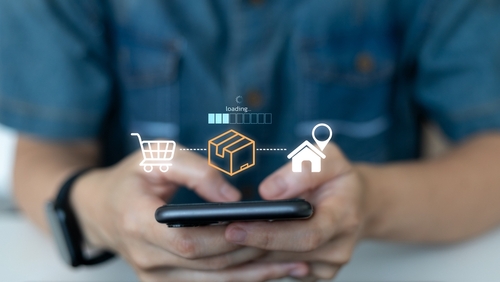Sep 22, 2025
The Balancing Act of Shipping a Package to Poland

Overnight freight, global logistics, and shipping a package to Poland and other countries once sounded impossible. But Frederick Smith, the mastermind behind FedEx, pushed forward anyway.
He built the "hub-and-spoke" system, where packages move through one giant sorting center before being shipped out quickly. This simple but smart setup revolutionized global shipping.
With laws relaxing in 1977, this new way of doing things took root, creating room for bold ideas to grow. The much older company, UPS, stepped up soon after, forming UPS Airlines in 1988 and jumping into air freight with both feet.
While most people had no idea what was coming, these early decisions shaped everything that followed. Eventually, the modern conveniences of consolidated shipping services evolved within this growing international ecosystem.
Forging the Transatlantic Highway: Shipping a Package to Poland
When it comes to the rich history behind shipping a package to Poland, Europe and other countries around the world, FedEx didn’t slowly inch into global power. Instead, one bold move flipped the switch when it bought Flying Tiger Line in 1989.
With Flying Tiger already touching 58 countries on six continents, FedEx suddenly jumped from a national player to the biggest cargo carrier worldwide. The company sped past the slow-build route that could've taken a lifetime. In contrast, UPS handled things differently, choosing to expand step by step and adding new routes with patience instead of buying its way in.
FedEx’s expansion showed up in real ways, as they poured more than €600 million into their Paris-Charles de Gaulle hub. This site grew into its largest hub outside the United States and became a heartbeat for business in the area.
UPS didn’t sit still either, doubling its space with a €111 million investment at its main Cologne/Bonn site, which first opened in 1986. With this expansion, the company’s system could sort 110,000 packages every hour.
These weren’t just big numbers on paper. You could see the impact in busy airports, high-speed sorting lines, and bustling warehouses. It was proof the connection across the Atlantic wasn’t just an idea, but a tangible idea you could watch unfold.
Europe and Poland’s Logistical Renaissance
Everything changed in Poland after 1989, when the early seeds were planted for conveniently and securely shipping a package to Poland.
With the shift to a free-market economy, the old state postal service faced intense competition as foreign companies, like FedEx and UPS, rushed in, worked faster. They won over 97 percent of the courier business almost overnight.
FedEx jumped in soon after the market opened, and years later, in 2012, it made a smart play as part of its bigger push in Europe by buying the Polish courier service, Opek, for $54 million. This buyout gave FedEx a ready-made ground network, along with three hubs and over 1,200 new staff.
With this jumpstart, FedEx could move faster than the market and immediately compete with homegrown companies, matching their local know-how and service range. This entire storyline is directly related to the psychology and drive of Polish consumers.
“What makes the Polish consumers tick? The primary factors driving shopping preferences for Poles include competitive pricing, a broad product selection, swift delivery, and enticing promotions,” according to Ecommerce Germany. “As fuel prices continue to rise, consumers are increasingly inclined to opt for online shopping, saving money on transportation and time. This shift in behaviour applies to significant purchases like household goods, appliances, and consumer electronics, as well as smaller ones, notably clothing and fashion accessories.”
Historical Milestones and Shipping a Package to Poland
Here’s a look at the most important turning points in the history of shipping a package to Poland, starting with the idea of overnight delivery. This paved the way for the physical buildings and networks that would eventually make a digital economy possible.
Change did not happen all at once. Rather, each milestone built on the last, with every move forward opening up new possibilities:
|
Year |
Company |
Milestone |
Significance |
|
1971 |
FedEx |
Federal Express is incorporated |
Birth of the modern express delivery concept. |
|
1977 |
U.S. Congress |
Public Law 95-163 is passed |
Deregulated U.S. air-cargo, a key legislative catalyst for growth. |
|
1979 |
FedEx |
Launches COSMOS |
Pioneered package tracking and tracing services. |
|
1984 |
FedEx |
Acquires Gelco Express International |
Expands international service to 84 countries. |
|
1986 |
UPS |
Establishes main European gateway at Cologne/Bonn |
Creates a core air hub for European operations. |
|
1988 |
UPS |
Found UPS Airlines |
Formally enters the air cargo business to expand its network. |
|
1989 |
FedEx |
Acquires Flying Tiger Line |
Acquires the world's largest cargo airline, instantly gains global scale. |
|
1999 |
FedEx |
Opens European hub at Paris-CDG |
Establishes a major presence in Europe with the largest hub outside the United States. |
|
2006 |
UPS |
Expands Cologne/Bonn hub |
Massive investment to double sorting capacity and facility size. |
|
2012 |
FedEx |
Acquires Opek in Poland |
Gained an immediate nationwide domestic ground network in an emerging market. |
|
2014 |
UPS |
Acquires Poltraf in Poland |
Targeted investment in the high-growth healthcare logistics sector. |
A Tale of Two Strategies
UPS and FedEx took very different routes in Poland, and each move spoke volumes about their worldwide operations. Instead of buying a huge local player, UPS focused on high-value sectors, as demonstrated by its 2014 purchase of Poltraf, which specialized in temperature-controlled transport and expert warehouse systems.
This deal fit UPS’s plan to create a network for sensitive products like medicines, and it aligned with their existing approach in Hungary and the UK. It prioritized precision over making a big domestic splash.
Meanwhile, FedEx made a broad play, snapping up a local network to cement its presence. Both companies showed how strategy changes based on local needs, and their choices in Poland echo their larger worldwide strategies.
It's like watching two grandmasters play with totally different styles, as years of experience spill into each country they enter.
“In this unpredictable global environment, firms face immense challenges in balancing resilience and competitiveness,” according to the Institute of Electrical and Electronics Engineers's (IEEE) Technology and Engineering Management Society. “Exploring innovative strategies and solutions to mitigate these risks is critical for ensuring the stability and efficiency of global supply chains.”
Shipping a Package to Poland: From Tracking to Predicting
Shipping a package to Poland and watching parcels cross continents feels futuristic, but the experience still has its limits. Early tracking systems, like FedEx’s COSMOS in 1979, could only tell you where your package last stopped.
Today, tiny sensors, GPS, and RFID tags send updates without human help, allowing logistics firms to monitor not just location, but also temperature and humidity. This is vital for products like medicine.
FedEx’s SenseAware ID checks each item hundreds of times, while its Surround platform pulls in data like weather to predict and prevent problems. Similarly, UPS uses its "Innovation Driven" system, which relies on real-time numbers and patterns for quick decisions.
Yet, despite all this technology, customers still feel left out. A company might know a package is facing delays, but your tracking screen just says “in transit.” You're left waiting, and even though the data is out there, the details stay hidden, making the experience feel stuck in the past.
In the middle of this operational evolution, Poland’s economy has taken off fast, and people switched to online shopping en masse. This shift, combined with global delivery services showing up everywhere, meant shoppers in Warsaw could suddenly order things from London or Paris with a few clicks. As choices exploded, the old way of shopping quickly felt outdated.
What’s more is: building up European hubs has caused express package numbers to soar between North America and Europe long before online shopping exploded in the 2000s. Major carriers have seen their volumes grow fast even without any push from e-commerce.
Now that new shipping systems have taken away most of the old delivery worries, people feel much safer buying things from other countries, and trust in online orders has really jumped.
The Customs Conundrum
Sending something overseas, and especially shipping a package to Poland, seems easier now. Platforms like FedEx Electronic Trade Documents take care of most of the forms and get packages pre-cleared, which cuts down on waiting.
It often feels as simple as sending something down the street, especially with tools like the U.S. Postal Service’s online shortcuts that match items with the right customs codes after you describe what’s inside the box. You just type and click, and then move on with your day.
But here’s where things get tricky. That shortcut for you doesn’t make things easier for the person waiting on the other end, such as a friend in Poland who ordered a gadget and is suddenly surprised with unexpected customs taxes and fees. All that tech means nothing when the package stalls in customs limbo, maybe because the form missed a detail or the declared value looked off, causing customs to flag the shipment.
Your friend might wait for weeks, wondering what went wrong. The process moved fast at first, then hit an invisible wall, and until someone pays or sends new information, the box just sits there.
This is where the whole system can feel like it falls apart, right at the very end when it matters most.
Consumer Realities and the Last-Mile Proposition
Shipping a package to Poland from the United States is rarely straightforward.
Companies promise smooth sailing, but real stories online suggest headaches start at customs, with people often mentioning packages sitting in Warsaw for weeks or even months. Customs sometimes asks for VAT (Value Added Taxes) and fees that can double the price of what’s being shipped, even with low-value items.
Big shipping companies boast about their huge networks, and while most of the journey might go smoothly, local delivery often causes the most stress. Polish customers say that local partners make or break the process, and some folks swear by domestic delivery services with popular parcel lockers.
It seems who finishes the delivery matters much more than who started it.
“The period 2020-2021, marked by the closure of traditional, stationary stores and a radical change in the lifestyle of millions of consumers, was a time of rapid expansion that permanently changed the retail landscape in Poland,” states Warsaw Enterprise Institute. “It was a period when the main challenge for companies was to keep up with the wave of new customers who were moving their shopping en masse to online retailers. Today, however, the sector is facing completely different challenges.”
Future Hurdles, Logistics, and Shipping a Package to Poland
Global logistics has changed, with trade wars and policy shifts taking center stage as consumers and businesses look into shipping a package to Poland. Companies now build supply chains that can weather storms, not just cut costs, as new U.S. rules have driven policies on the $800 de minimis exemption, making cheaper imports subject to duties and taxes.
Some American shoppers now face the headaches Polish consumers have long known, as cross-border buys get pricier and trickier.
Moreover, speed used to be everything in shipping, and air freight ruled the game. But as it turns out, planes pump out a mountain of carbon gas.
One ton of product sent by air means 500 grams of CO2 per kilometer, which dwarfs emissions from trucks or ships. Businesses that raced goods around the globe must now wrestle with a environmental policies.
Big names are watching their carbon footprints, as demonstrated by FedEx's goal to be carbon-neutral by 2040 and its rollout of tools that show customers the environmental cost of shipping. By 2030, “green logistics” might be worth $350 billion, but the real test is whether fast-shipping brands can keep their identity while making the switch to cleaner, cheaper delivery.
The future will demand some clever balancing acts. However, consolidated shipping services for parcels, packages, documents, cars, and relocation services are innovating to meet today’s standards for convenient, safe, and secure international deliveries.
Polonez America
Polonez America specializes in international shipments from the United States to 43 European countries and specifically shipping a package to Poland. We offer parcel shipment via ocean or air, vehicle shipment, commercial LCL (Less than Container Load) and FCL (Full Container Load) shipping.
Our comprehensive range of services means customers can initiate package or commercial shipments from any of Polonez's authorized shipping outlets within the United States, which are then transported to our headquarters for sorting. Customers can send packages from authorized shipping outlets in the United States or by sending them via UPS, FedEx, or U.S. Postal Service to Polonez America's headquarters in Port Reading, NJ.
Polonez America is your expert in the resettlement process, collaborating with European partners for parcel services, customs, and delivery within Poland and other countries. We earn client trust through integrity and professionalism by delivering the highest quality service at the most competitive price.
Recommended to you

News
Nov 10, 2025
Biggest Deal of the Year – 20% OFF ONLINE Shipments
It’s the biggest deal of the year, and the perfect time to send your Christmas parcels online with Polonez! For 2 weeks only (November 16-November 31, 2025), enjoy 20% OFF all online shipments when you use the code BLACK at checkout.

News
Oct 27, 2025
Track a Shipment to Poland with Cutting-Edge Monitoring
When a piece of home is sent across the Atlantic, the very first step is learning how to track a shipment to Poland.

News
Oct 20, 2025
Kielbasa, Consolidation, and Poland Package Forwarding
For customers utilizing Poland package forwarding services, sending a box from Detroit, Chicago, Pittsburgh, or New York to Warsaw was once an overwhelming, anxiety-inducing ordeal.




